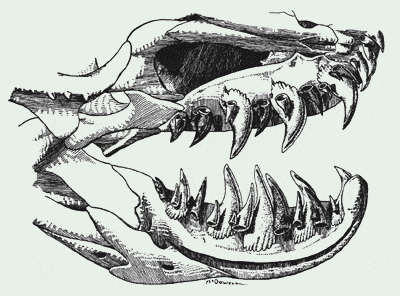top of page
HELODERMA
The lifespan of these lizards was published in the past to be around thirty years. I personally know of three animals that lived well over fifty, one of which was captured as a young adult in 1969 and is still alive and well. In my opinion Heloderma horridum can live up to seventy years or longer in optimum conditions. Females, average adult size is 24-30 in and two and a half to four pounds. Males, average adult size is 28- 34 in and three to five pounds. Exceptionally large males can reach 40in and close to ten pounds.
The Mexican Beaded Lizard and the Gila Monster are the only two venomous lizards in the world. The Beaded Lizard’s name in Latin consists of the two words Heloderma horridum. Heloderma, meaning nail studed skin, and horridum, meaning horrible (horrible studded lizard). Heloderma lizard's skin consists of several tiny beads called ostioderms. Each bead contains a tiny piece of bone that gives them an armor like plated skin.

Beaded Lizards can reach sexual maturity at three and a half to four years old, although I have successfully bred them at three. In H.horridum and H.exasperatum, once oviposition occurs the incubation period at 80-84F is 180-185 days. In H.alvarezi the incubation time at the same temperature is one hundred fifty to one hundred fifty five days (S.Angeli, Q. Dwyer 2020). At about those periods of time the hatchlings will pip their head out of the egg. It usually takes two or three days for them to come all the way out, absorbing their yolk sack and ingesting the liquid content of their egg. Newly hatched neonates are usually five to six inches and weigh around 25- 40 grams. Until the animals are substantial in size, sexing is nearly impossible. Males generally have broader heads and longer necks, with females having narrower heads and shorter necks, although there’s always exceptions to every rule.





Types of Beaded Lizards
Class: Reptilia Order: Squamata Family: Helodermatidae
• Heloderma horridum
• Heloderma charlesbogerti
• Heloderma alvarezi
• Heloderma exasperatum


From top to bottom: An adult, a two year and a yearling
Size Comparison: Male on the left, Female on the right
The animals originate in the Pacific Drainages from Southern Sonora, Mexico to Southwestern Guatemala and two Atlantic drainages, from Central Chiapas, Mexico to Southeastern Guatemala. Habitat is primarily tropicial deciduous forest and thorn scrub forest, also found in pine-oak forest, with elevations from sea level to 1500 meters. In the wild, the animals are only active from April to mid-November. They spend only about an hour per day above the ground, and their natural diet is consistent of reptile and bird eggs and occasionally small mammals. The lizard uses its venom primarily as a defensive weapon. (Johnson, J. P. and C. Ivanyi, 2001. North American Regional Beaded Lizard Studbook. 3rd Edition. Arizona-Sonora Desert Museum.)


H.h. exasperatum habitat - Southern Sonora, Mexico
Photography by C.M. Gienger
A Rio Fuerte beaded lizard in climbing a tree. Photography by C.M. Gienger
The venom glands are located in the lower jaw. At the base of each tooth is a grooved pit for venom delivery. The venom is delivered by the lizard by a chewing motion, a rather crude delivering device. The bite from an animal is extremely painful and can be potentially fatal, but this is only in extremely rare cases. See Bob Applegate's website for an actual bite account.


To the left: A tooth of a Heloderma horridum, notice the pit in the tooth.
To the right: The Jaw of a Gila Monster (Similar to a Beaded Lizard)
Both drawings come from Bogart and Del Campo's The Gila Monster and Its Allies and were drawn by S.B. McDowell ©1956
bottom of page


